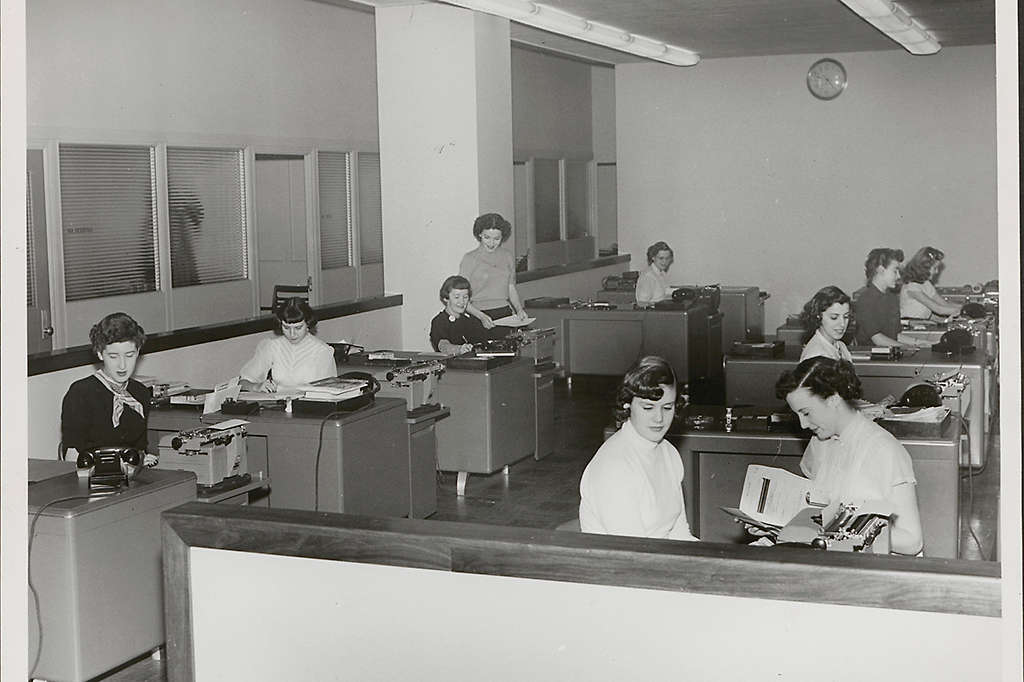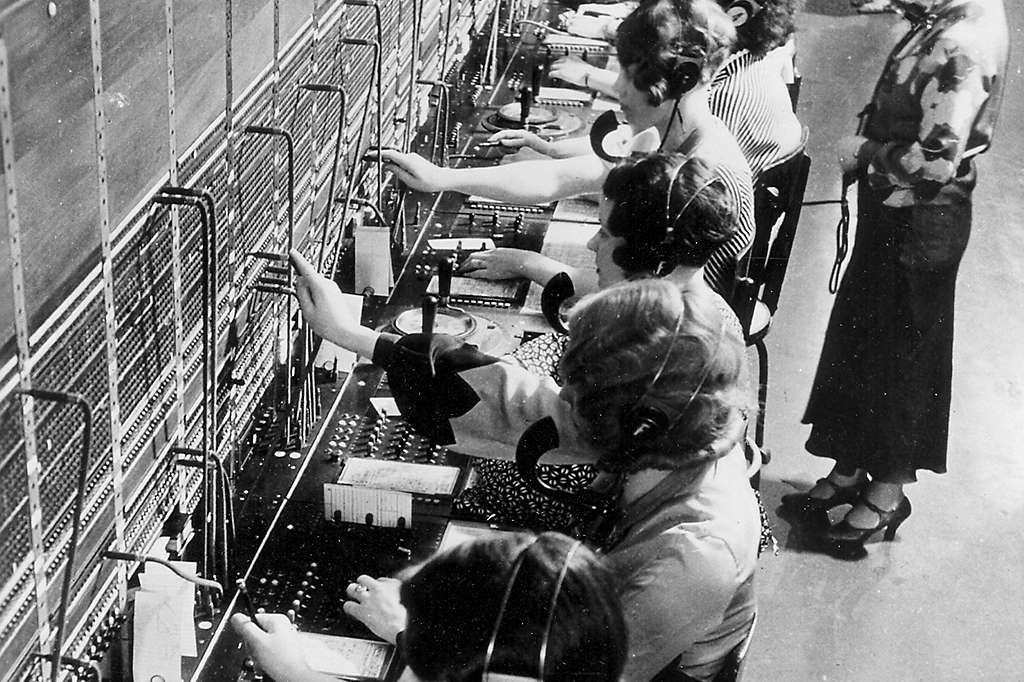History
From women’s suffrage, to progress towards gender equality
New York Life | December 28, 2021

Above: Photograph of women working in the New York Life field training department, 1953.
Below: Photograph of the women of New York Life operating a switchboard in the 1930s.
To mark Women’s History Month, we celebrate great women—from the activists of the suffrage movement to the present day—and reflect on our own role in female empowerment.
Over the past year we’ve been proud to support an exhibition at the New York Historical Society entitled “Women March.” Created to commemorate the centennial of women’s suffrage, the exhibition celebrated 200 years of women’s collective action, while also featuring biographies of 54 key figures who helped galvanize the movement. These individuals kickstarted the progress towards full and equal rights for women that continues today in the “Me Too” movement and the election of our first female vice president.
The fight for suffrage
One of the most famous figures in the women’s suffrage movement is Susan B. Anthony. Originally drawn to politics through the abolitionist and temperance movements, she became an avid women’s rights activist after meeting Elizabeth Cady Stanton in the early 1850s. In 1868, the pair became the editors of the political magazine Revolution, and in 1869 they founded the National Woman Suffrage Association (NWSA). Originally part of the broader suffrage movement, their feelings of betrayal when gender was omitted from the 15th Amendment (which declares that U.S. citizens’ right to vote “shall not be denied or abridged . . . on account of race, color, or previous condition of servitude”) precipitated a split from the broader movement. Anthony continued to press for suffrage her entire life and was arrested for attempting to vote in 1872.
On August 26, 2020, to mark the centenary of the ratification of the 19th Amendment, which gave women the right to vote, a 14-foot-tall bronze statue of Anthony, Stanton, and Black women’s rights pioneer, Sojourner Truth, was unveiled in New York City’s Central Park. A live-streamed ceremony included recitals of suffragist writings by actors Viola Davis, Meryl Streep, and America Ferrera, while former Secretary of State Hillary Clinton made an in-person address.1 New York Life is proud to have made a significant contribution to the fund that paid for the statue.
New York Life has an intriguing connection to Anthony, in that both her father and her brother were employed as New York Life agents. In fact, Anthony herself was one of New York Life’s first female policyholders, using the cash value of her life insurance policy as collateral to help get women admitted to the University of Rochester in New York for the first time in 1900.
Among the many other interesting figures in the women’s suffrage movement are the five Rollin sisters, Frances Ann, Katherine, Charlotte, Marie Louise, and Florence. Born into a free Black family in Charleston, South Carolina, the Rollin sisters became staunch activists for equal rights across race and gender during the Reconstruction period. In 1869, Charlotte Rollin made a remarkable speech on the floor of South Carolina’s statehouse in which she declared, “We ask suffrage not as a favor, not as a privilege, but as a right based on the grounds that we are human beings and as such entitled to all human rights.”
A legacy which is relevant today
From the perspective of the advancement of women, 2021 has already secured its place in history with the swearing in of Kamala Harris as the first-ever female vice president of the United States. Yet, while there can be no doubt women’s rights have come a long way in the past 200 years, the events of 2020 have highlighted that there’s still much to do. The recession caused by COVID-19 has led to nearly one million more job losses for women than for men, mainly due to women being overrepresented in the worst hit sectors.2 At the same time, pressure on the childcare sector threatens to have a severe detrimental effect on the progress of women in the workforce, as the pandemic has caused many women to become the primary source of childcare in their households; a report by the Center for American Progress found that 4.5 million child care slots were in danger of being lost permanently, at a potential cost to the US economy of $64.5 billion.3

Our commitment to gender equality
As a business, we have a long tradition of supporting the rights and advancement of women. In 1885 Winifred Supple became the first woman to work for us, just one of many female trailblazers at New York Life. Nine years later we became the first US provider to offer life insurance to women at the same cost as men—at a time when married women still didn’t have the right to own property in their name.
We’re also among the Best Employers for Diversity in Forbes’s annual list – and ranked #31 in the top 500 organizations.
We’re proud to be on the list of Seramount’s 2021 100 Best Companies, as well as being among their 2022 Top Companies For Executive Women, and 2022 Best Companies For Multicultural Women. Meanwhile, campaigner for women in technology AnitaB.org named us as a 2022 Leader on the list of Top Companies for Women Technologists.
This year to celebrate Women’s History Month, New York Life’s women’s Employee Resource Group is hosting Michele Buck, Chairman, President & CEO of the Hershey Company and New York Life’s Board of Directors’ Lead Director. There will also be a panel with Monumental Women’s President, Pam Elam, sculptor, Meredith Bergmann, and Kinshasha Holman Conwill, deputy director of the National Museum of African American Culture and Heritage (and a jurist for the statue competition). There will also be opportunities for networking with senior leaders and learning about colleagues’ experiences volunteering.
The legacy of Anthony, Stanton, Truth, and other activists serves as a powerful reminder of the progress that’s possible when people stand together. We’re proud to be a part of that movement, today as in the past.
1McGreecy, Nora. “Why the First Monument of Real Women in Central Park Matters—and Why It’s Controversial”. Smithsonian Magazine. Published 08/26/2020. Accessed 02/04/2021. https://www.smithsonianmag.com/smart-news/monument-controversy-women-pioneer-central-park-180975662/
2Boesch, Diana; Phadke, Shilpa. ‘When Women Lose All the Jobs: Essential Actions for a Gender-Equitable Recovery’. Center for American Progress website. Published 02/01/2021. Accessed 02/04/2021. https://www.americanprogress.org/issues/women/reports/2021/02/01/495209/women-lose-jobs-essential-actions-gender-equitable-recovery/
3Kashen, Julie; Glynn, Sarah Jane; Novello, Amanda. ‘How COVID-19 Sent Women’s Workforce Progress Backward’. Center for American Progress website. Published 10/30/2020. Accessed 02/04/2021. https://www.americanprogress.org/issues/women/reports/2020/10/30/492582/covid-19-sent-womens-workforce-progress-backward/
RELATED CONTENT
Go back to our newsroom to read more stories.
Media contact
Kevin Maher
New York Life Insurance Company
(212) 576-7937
Kevin_B_Maher@newyorklife.com
